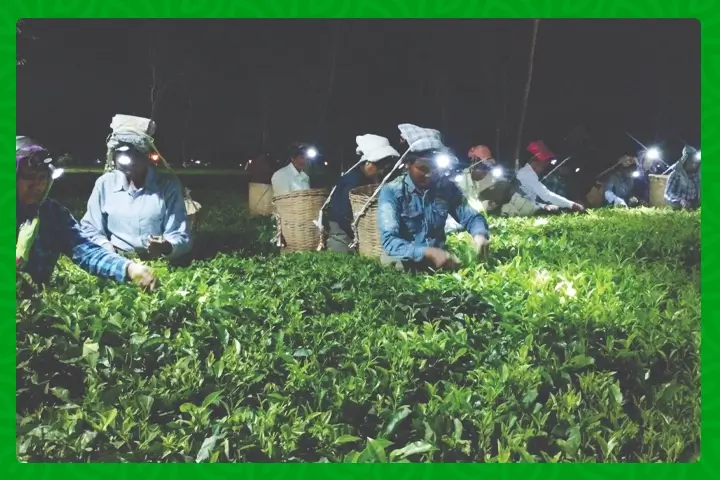
Tea cultivation has evolved over the years, with innovative practices emerging to enhance flavor profiles and preserve the natural essence of the leaves. One such intriguing method gaining popularity is Moonlight Tea Harvesting, a process that aligns with the principles of organic farming and sustainable agriculture. In this article, we delve into the science behind Moonlight Tea Harvesting, exploring its impact on flavor, aroma, and the overall quality of the final brew.

Tea is one of the most popular beverages in the world, with a rich history and culture that spans across continents and centuries. Tea lovers appreciate the variety and complexity of flavors and aromas that different types of tea can offer, from the delicate and floral white teas to the robust and malty black teas. But did you know that the time of day when tea leaves are harvested can also affect the quality and taste of the tea?
Moonlight Tea Harvesting involves plucking tea leaves under the soft glow of the moon during specific phases of its cycle. The unique combination of lunar influence, temperature, and atmospheric conditions during the night is thought to contribute to the distinctive taste and aroma of Moonlight Tea.
This method is practiced by some tea farmers in China, India, and other countries, this practice is rooted in the belief that moonlight enhances the accumulation of essential oils and flavor compounds in tea leaves. But what is the science behind this practice, and how does it work?
The Effect of Moonlight on Tea Plants

Tea plants, like most plants, undergo a process called photosynthesis, which converts light energy into chemical energy that the plant can use to grow and produce leaves, buds, and flowers. During the day, the plant absorbs light from the sun and uses it to produce sugars and other organic compounds. At night, the plant switches to a process called respiration, which breaks down the sugars and releases energy for the plant’s metabolism.
However, when the plant is exposed to moonlight, the photosynthesis process does not stop completely, but continues at a slower rate. This means that the plant can still produce sugars, but at a lower amount than during the day. The plant also produces less water and oxygen, and more carbon dioxide, which affects the acidity and alkalinity of the plant’s cells.
The reduced photosynthesis and respiration rates also affect the production of certain chemicals in the plant, such as polyphenols, amino acids, and caffeine. Polyphenols are a group of antioxidants that give tea its color, flavor, and health benefits. Amino acids are the building blocks of proteins, and some of them, such as theanine, contribute to the sweetness and umami taste of tea. Caffeine is a stimulant that can boost alertness and energy levels.
According to some studies, moonlighting can increase the content of polyphenols, amino acids, and caffeine in tea leaves, compared to leaves harvested during the day. This can result in a tea that has a richer flavor, a smoother texture, and a stronger effect on the body and mind.
The Effect of Moonlight on Tea Farmers

Tea moonlighting is not only a science but also an art and a tradition. Tea farmers who practice moonlighting have to follow a strict schedule and a careful technique to ensure the quality and safety of the tea. Moonlighting is usually done during the full moon or the waxing moon when the moonlight is brightest and most stable. The farmers have to wait until the moon rises above the horizon, and then start picking the tea leaves by hand, using a flashlight or a lantern to guide them.
The farmers have to be gentle and precise, picking only the young and tender leaves and buds, and avoiding any damage or contamination. The leaves are then quickly processed and dried, using methods that vary depending on the type of tea. For example, white tea is simply withered and dried, while green tea is steamed or pan-fried to stop the oxidation process. The tea is then stored in a cool and dark place, away from moisture and sunlight, until it is ready to be brewed and enjoyed.
Tea moonlighting is a labour-intensive and time-consuming process, but it is also a rewarding and meaningful one. Tea farmers who practice moonlighting have a deep respect and appreciation for the tea plant, the moon, and nature. They believe that moonlighting can capture the essence and the spirit of the tea and create a tea that is not only delicious but also magical.
The Effect of Moonlight on Tea Drinkers
Tea moonlighting is a rare and exquisite experience that can delight and enchant tea drinkers. Moonlight tea has a unique and distinctive flavor and aroma, that can vary depending on the type of tea, the season, and the weather. Some moonlight teas have a floral and fruity note, while others have a nutty and woody note. Some moonlight teas have a light and refreshing taste, while others have a full and rich taste. Some moonlight teas have a calming and soothing effect, while others have a stimulating and energizing effect.
Moonlight Tea Harvesting is more than a traditional practice; it’s a harmonious blend of science and nature. Absence of artificial light sources during harvesting reduces the ecological impact, and the reliance on natural lunar cycles promotes a sustainable approach to tea cultivation.The interplay of moonlight, temperature, and atmospheric conditions contributes to the creation of a tea that tantalizes the senses.
Anil M V, Founder, Organil Services
Organil Services are Registered for Organic Regulatory Certification Consultancy and Accreditation Services in the Industry. WhatsApp for a Prepaid Consultancy +91 8606551335 or Email : orgnil40@gmail.com.


















